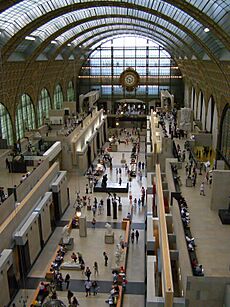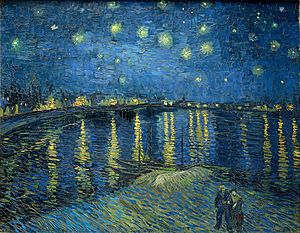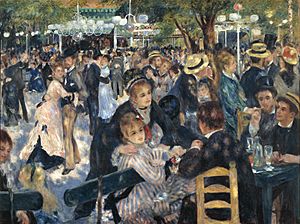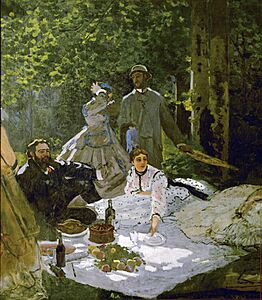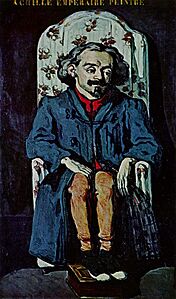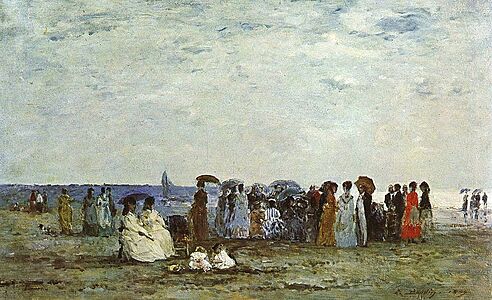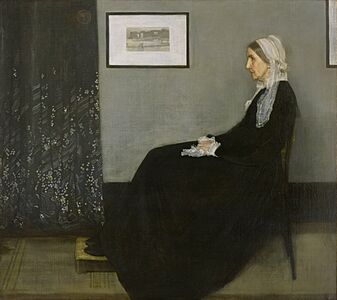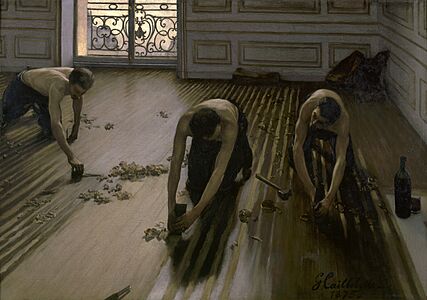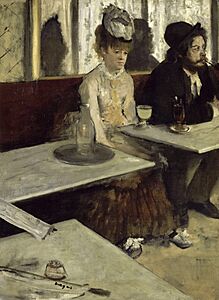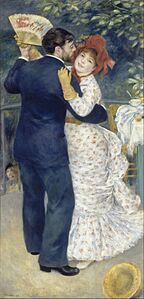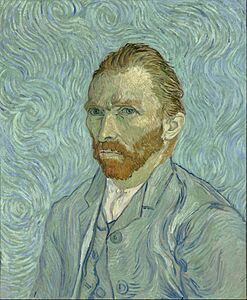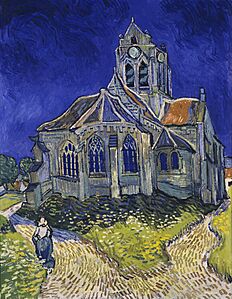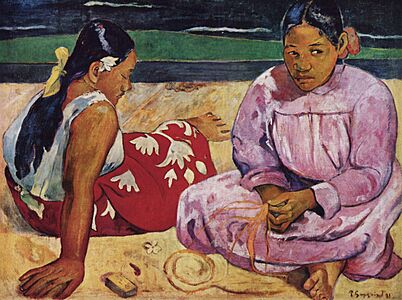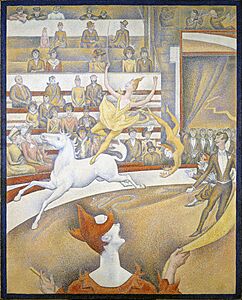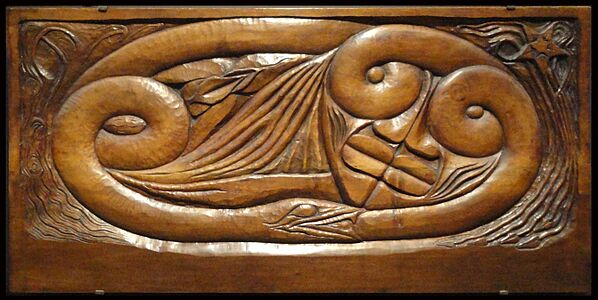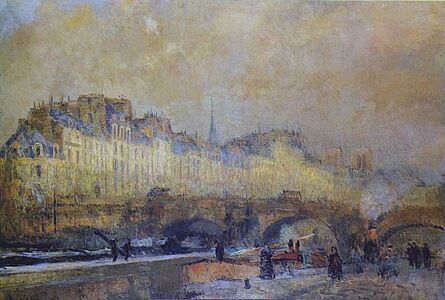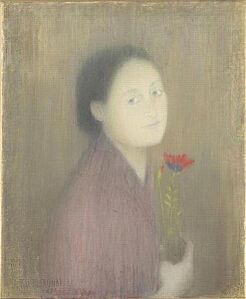Musée d'Orsay facts for kids
 |
|

The Musée d'Orsay as seen from the Passerelle Léopold-Sédar-Senghor
|
|
| Established | 1986 |
|---|---|
| Location | Rue de Lille 75343 Paris, France |
| Type | Art museum, Design/Textile Museum, Historic site |
| Visitors | 3.9 million (2023) |
| Public transit access | |
The Musée d'Orsay (which means Orsay Museum) is a famous museum in Paris, France. It sits on the Left Bank of the Seine River. This museum is special because it's inside an old train station called Gare d'Orsay. This station was built between 1898 and 1900 in a beautiful style called Beaux-Arts.
The museum mainly shows French art from 1848 to 1914. You can see paintings, sculptures, furniture, and old photographs there. It has the world's largest collection of Impressionist and post-Impressionist art. Famous artists like Claude Monet, Édouard Manet, Degas, Renoir, Cézanne, van Gogh, and Gauguin have their masterpieces here. Many of these artworks were moved from another gallery before the museum opened in 1986. The Musée d'Orsay is one of the biggest art museums in Europe.
In 2022, about 3.2 million people visited the museum. It was the sixth most-visited art museum in the world that year. In France, it was the second most-visited art museum, right after the Louvre.
Contents
History of the Museum
The building that is now the museum was first a railway station. It was called Gare d'Orsay and was built right next to the Seine River. Its location was perfect for travelers coming into Paris. The station was built for the Paris to Orléans railway company. It was finished just in time for the 1900 World's Fair. Three architects designed it: Lucien Magne, Émile Bénard, and Victor Laloux.
The station's design was seen as a bit old-fashioned for its time. Trains were very new and modern, so people expected a building that looked just as new. Instead, the Gare d'Orsay looked back to older styles. It even hid the modern technology inside its classic facade. It served as the main station for trains from southwestern France until 1939.
By 1939, the station's platforms were too short for the longer trains being used. After that, it was used for local train services. During World War II, part of it became a mailing center. Later, it was used as a set for movies and a temporary home for a theater company.
In the 1970s, work began on a new underground train line, line C. A new station was built beneath the old one. In 1970, there was a plan to tear down the old station. However, Jacques Duhamel, who was in charge of cultural affairs, stopped this plan. The station was then protected as a historic monument in 1978.
The idea to turn the station into a museum came from the Museum of France. They wanted a museum that would connect the art collections of the Louvre and the National Museum of Modern Art (at the Georges Pompidou Centre). This idea was approved, and a study began in 1974.
In 1978, a competition was held to design the new museum. A team of three young architects won the contract. They were Pierre Colboc, Renaud Bardon, and Jean-Paul Philippon. Their plan added 20,000 square meters (about 215,000 square feet) of new space across four floors. The construction was done by Bouygues.
In 1981, Italian architect Gae Aulenti was chosen to design the inside of the museum. She planned the layout, decorations, and furniture. Her design used the three main levels under the museum's large arched roof. On the main floor, a central area was created from the old train platforms. These structures helped organize the large sculpture and gallery spaces. By July 1986, the museum was ready for its art. It took six months to place over 2,000 paintings, 600 sculptures, and other artworks. The museum officially opened in December 1986.
Today, about 3,000 art pieces are always on display at the Musée d'Orsay. Inside, there's a cool 1:100 scale model of the Paris Opera and the area around it. This model is under a glass floor that visitors walk on. It helps people understand how Paris was planned, making it a very popular attraction.
The museum also has a special collection called "A Passion for France: The Marlene and Spencer Hays Collection." This collection was given by Marlene and Spencer Hays, who are art collectors from Texas. They started collecting art in the early 1970s. In 2016, the museum agreed to keep their collection of about 600 artworks together. This was the largest donation of foreign art to France since World War II. The collection mostly features post-impressionist works. Artists like Bonnard, Vuillard, and Edgar Degas are included.
To make space for new art, the Musée d'Orsay is undergoing a big change. This project, called Orsay Grand Ouvert (Orsay Wide Open), is partly funded by a generous donation of €20 million from an anonymous US supporter. The project is expected to be finished in 2026. It will add new galleries and educational areas.
Outside the museum, there are six large bronze statues in a row. These statues represent different continents and were first made for the 1878 World's Fair:
- South America by Aimé Millet
- Asia by Alexandre Falguière
- Oceania by Mathurin Moreau
- Europe by Alexandre Schoenewerk
- North America by Ernest-Eugène Hiolle
- Africa by Eugène Delaplanche
Art Collection
Paintings: Famous Artists and Works
The Musée d'Orsay has an amazing collection of paintings from many important artists. Here are some of the major painters and their famous works you can see:
- Frédéric Bazille – 6 paintings, including The Family Reunion
- Pierre Bonnard – 60 paintings, including The Chequered Blouse
- William-Adolphe Bouguereau – 12 paintings, including The Birth of Venus
- Gustave Caillebotte – 7 paintings, including The Floor Scrapers
- Paul Cézanne – 56 paintings, including Apples and Oranges and The Card Players
- Gustave Courbet – 48 paintings, including The Artist's Studio and A Burial at Ornans
- Edgar Degas – 43 works, including paintings like The Parade and L'Absinthe
- Paul Gauguin – 24 paintings, including Arearea and Tahitian Women on the Beach
- Vincent van Gogh – 24 paintings, including Bedroom in Arles, Self Portrait, and Starry Night
- Jean Auguste Dominique Ingres – 4 paintings, including The Source
- Édouard Manet – 34 paintings, including Olympia and The Luncheon on the Grass
- Jean-François Millet – 27 paintings, including The Angelus and The Gleaners
- Claude Monet – 86 paintings, including The Saint-Lazare Station, Blue Water Lilies, and Haystacks
- Pierre-Auguste Renoir – 81 paintings, including Bal au moulin de la Galette, Montmartre and The Bathers
- Georges Seurat – 19 paintings, including The Circus
- Alfred Sisley – 46 paintings, including Inondation at Port-Marly
- James McNeill Whistler – 3 paintings, including Whistler's Mother
Sculptures
In the 1800s, sculptures were very popular. They were often used to show a person's importance or power. However, by the mid-1900s, many of these sculptures were put away and not displayed anymore. When the Orsay railway station was turned into the Musée d'Orsay in the 1970s, many 19th-century sculptures were brought out again. The large open space inside the new museum was perfect for showing them off.
When the museum first opened in December 1986, it had 1,200 sculptures. These came from places like the Louvre and other collections. The museum also received over 200 sculptures as gifts from art lovers and artists' families.
Since then, the museum has added more sculptures. Some came from exchanges with other museums, like Nature Unveiling Herself Before Science by Louis-Ernest Barrias. They also acquired famous works like The Thinker and The Gates of Hell by Auguste Rodin. The museum also buys specific artworks to complete its collections, such as Maturity by Camille Claudel. Today, the Musée d'Orsay has more than 2,200 sculptures.
Some of the important sculptors whose works are in the collection include Auguste Rodin, Paul Gauguin, Camille Claudel, and Honoré Daumier.
Other Works of Art
Besides paintings and sculptures, the museum also has collections of:
- Architecture and decorative arts (like furniture and design)
- Photography
Selected Collection Highlights
-
Eugène Delacroix, The Lion Hunt, c. 1854
-
Jean-François Millet, The Gleaners, 1857
-
Claude Monet, Le déjeuner sur l'herbe, (right section), includes Gustave Courbet, 1865–1866
-
Paul Cézanne, Portrait of Achille Emperaire, 1868
-
Eugène Boudin, Bathers on the Beach at Trouville, 1869
-
James McNeill Whistler, Whistler's Mother, 1871
-
Gustave Caillebotte, Les raboteurs de parquet (The Floor Scrapers), 1875
-
Edgar Degas, L'Absinthe, 1876
-
Pierre-Auguste Renoir, Dance in the Country (Aline Charigot and Paul Lhote), 1883
-
Paul Sérusier, The Talisman/Le Talisman, 1888
-
Self-portrait (1889) by Vincent van Gogh
-
Vincent van Gogh, The Church at Auvers, 1890
-
Paul Gauguin, Tahitian Women on the Beach, 1891
-
Georges Seurat, The Circus, 1891
-
Louise Catherine Breslau, Portrait of Henry Davison, 1880
-
Joaquín Sorolla, La Vuelta de la Pesca, 1894
Museum Directors
Here are the people who have been in charge of the Musée d'Orsay:
- Françoise Cachin: 1986 – 1994
- Henri Loyrette: 1994 – 2001
- Serge Lemoine: 2001 – 2008
- Guy Cogeval: March 2008 – March 2017
- Laurence des Cars: March 2017 – September 2021
- Christophe Leribault: October 2021 – present
See also
 In Spanish: Museo de Orsay para niños
In Spanish: Museo de Orsay para niños
- List of museums in Paris
- List of largest art museums
- List of most-visited art museums
- List of tourist attractions in Paris




